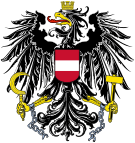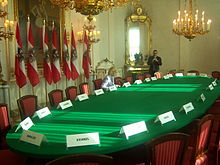Government of Austria
| Government of Austria | |
|---|---|
| Bundesregierung der Republik Österreich | |
 | |
| Overview | |
| Established | 31 October 1918 |
| Country | Austria |
| Leader | Chancellor |
| Appointed by | President |
| Ministries | 15 |
| Headquarters | Chancellery |
| Website | www |
| This article is part of a series on the |
| Politics of Austria |
|---|
 |
The Government of Austria (German: Bundesregierung der Republik Österreich) is the executive cabinet of the Republic of Austria. It consists of the chancellor, who is the head of government, the vice chancellor and the ministers.
Appointment
Since the 1929 reform of the Austrian Constitution, all members of the Federal Government are appointed by the Austrian Federal President.[1] As the Federal Government must maintain the confidence of parliament, the President must generally abide by the will of that body in his or her appointments. In practice, the leader of the strongest political party, who ran as a "chancellor candidate" in a parliamentary election, is usually asked to become Federal Chancellor, though there have been some exceptions. Ministers are proposed for nomination by the Chancellor, though the President is permitted to withhold his or her approval. Likewise, the President may dismiss the Chancellor and/or the whole government at any time. If this occurs, a new government must then be formed by the parties that control parliament.
Meetings

The government is convened for frequently scheduled meetings. When formally convened as such, the government is termed the
Federal Ministries
This section is empty. You can help by adding to it. (July 2022) |
There are currently twelve Federal Ministries that all make up the Austrian cabinet. [2]
- Federal Chancellery
- Federal Ministry for Arts, Culture, the Civil Service and Sport
- Federal Ministry for Agriculture, Forestry, Regions and Water Management
- Federal Ministry for Climate Action, Environment, Energy, Mobility, Innovation and Technology
- Federal Ministry of Defence
- Federal Ministry of Education, Science and Research
- Federal Ministry of European and International Affairs
- Federal Ministry of Finance
- Federal Ministry of the Interior
- Federal Ministry of Justice
- Federal Ministry of Labour and Economy
- Federal Ministry of Social Affairs, Health, Care and Consumer Protection
History
First Republic
After the dissolution of the
State Chancellor Renner had signed the Treaty of Saint-Germain-en-Laye, whereafter his cabinet retired en bloc. Re-elected by the Constitutional Assembly on 17 October 1919, his third cabinet was finally overturned with the break-up of the SPÖ-CS coalition on 7 July 1920. Renner was succeeded by the Christian Social politician Michael Mayr, who at the commencement of the Austria Constitution on 10 November 1920 became first Federal Chancellor of Austria. Mayr and his successors proceeded with the support of the Christian Social Party and the Greater German nationalists, while the Social Democrats remained in opposition.
From 5 March 1933 onwards, the Christian Social chancellor
Second Republic
On 27 April 1945 a provisional Austrian
List of cabinets since 1945:
| Governments of Austria | |||||||||
| Name of Government | Duration of Government | Chancellor | Vice-Chancellor | Parties Involved | Election | ||||
| Renner | April 27, 1945 – December 20, 1945 | Karl Renner1 | N/A | SPÖ, KPÖ |
none | ||||
| Figl I | December 20, 1945 – November 8, 1949 | Leopold Figl (ÖVP) | Adolf Schärf (SPÖ) | ÖVP, SPÖ, KPÖ | 1945
| ||||
| Figl II | November 8, 1949 – October 28, 1952 | Leopold Figl (ÖVP) | Adolf Schärf (SPÖ) | ÖVP, SPÖ | 1949
| ||||
| Figl III | October 28, 1952 – April 2, 1953 | Leopold Figl (ÖVP) | Adolf Schärf (SPÖ) | ÖVP, SPÖ | |||||
| Raab I | April 2, 1953 – June 29, 1956 | Julius Raab (ÖVP) | Adolf Schärf (SPÖ) | ÖVP, SPÖ | 1953
| ||||
| Raab II | June 29, 1956 – July 16, 1959 | Julius Raab (ÖVP) | Adolf Schärf (SPÖ), Bruno Pittermann (SPÖ)² | ÖVP, SPÖ | 1956
| ||||
| Raab III | July 16, 1959 – November 3, 1960 | Julius Raab (ÖVP) | Bruno Pittermann (SPÖ) | ÖVP, SPÖ | 1959
| ||||
| Raab IV | November 3, 1960 – April 11, 1961 | Julius Raab (ÖVP) | Bruno Pittermann (SPÖ) | ÖVP, SPÖ | |||||
| Gorbach I | April 11, 1961 – March 27, 1963 | Alfons Gorbach (ÖVP) | Bruno Pittermann (SPÖ) | ÖVP, SPÖ | |||||
| Gorbach II | March 27, 1963 – April 2, 1964 | Alfons Gorbach (ÖVP) | Bruno Pittermann (SPÖ) | ÖVP, SPÖ | 1962
| ||||
| Klaus I | April 2, 1964 – April 19, 1966 | Josef Klaus (ÖVP) | Bruno Pittermann (SPÖ) | ÖVP, SPÖ | |||||
| Klaus II | April 19, 1966 – April 21, 1970 | Josef Klaus (ÖVP) | Fritz Bock (ÖVP), Hermann Withalm (ÖVP)³ | ÖVP | 1966
| ||||
| Kreisky I | April 21, 1970 – November 4, 1971 | Bruno Kreisky (SPÖ) | Rudolf Häuser (SPÖ) | SPÖ | 1970
| ||||
| Kreisky II | November 4, 1971 – October 28, 1975 | Bruno Kreisky (SPÖ) | Rudolf Häuser (SPÖ) | SPÖ | 1971
| ||||
| Kreisky III | October 28, 1975 – June 5, 1979 | Bruno Kreisky (SPÖ) | Rudolf Häuser (SPÖ), Hannes Androsch (SPÖ)4 | SPÖ | 1975
| ||||
| Kreisky IV | June 5, 1979 – May 24, 1983 | Bruno Kreisky (SPÖ) | Hannes Androsch (SPÖ), Fred Sinowatz (SPÖ)5 | SPÖ | 1979
| ||||
| Sinowatz | May 24, 1983 – June 16, 1986 | Fred Sinowatz (SPÖ) | Norbert Steger (FPÖ) | SPÖ, FPÖ | 1983
| ||||
| Vranitzky I | June 16, 1986 – January 21, 1987 | Franz Vranitzky (SPÖ) | Norbert Steger (FPÖ) | SPÖ, FPÖ | |||||
| Vranitzky II | January 21, 1987 – December 17, 1990 | Franz Vranitzky (SPÖ) | Alois Mock (ÖVP), Josef Riegler (ÖVP)6 | SPÖ, ÖVP | 1986
| ||||
| Vranitzky III | December 17, 1990 – November 29, 1994 | Franz Vranitzky (SPÖ) | Josef Riegler (ÖVP), Erhard Busek (ÖVP)7 | SPÖ, ÖVP | 1990
| ||||
| Vranitzky IV | November 29, 1994 – March 12, 1996 | Franz Vranitzky (SPÖ) | Erhard Busek (ÖVP), Wolfgang Schüssel (ÖVP)8 | SPÖ, ÖVP | 1994
| ||||
| Vranitzky V | March 12, 1996 – January 28, 1997 | Franz Vranitzky (SPÖ) | Wolfgang Schüssel (ÖVP) | SPÖ, ÖVP | 1995
| ||||
| Klima | January 28, 1997 – February 4, 2000 | Viktor Klima (SPÖ) | Wolfgang Schüssel (ÖVP) | SPÖ, ÖVP | |||||
| Schüssel I | February 4, 2000 – February 28, 2003 | Wolfgang Schüssel (ÖVP) | Susanne Riess-Passer (FPÖ) |
ÖVP, FPÖ | 1999
| ||||
Schüssel II |
February 28, 2003 – January 11, 2007 | Wolfgang Schüssel (ÖVP) | Herbert Haupt (FPÖ), Hubert Gorbach (FPÖ/BZÖ)9 | ÖVP, FPÖ, BZÖ | 2002
| ||||
Gusenbauer |
January 11, 2007 – December 2, 2008 | Alfred Gusenbauer (SPÖ) | Wilhelm Molterer (ÖVP) | SPÖ, ÖVP | 2006
| ||||
Faymann I |
December 2, 2008 – December 16, 2013 | Werner Faymann (SPÖ) | Josef Pröll (ÖVP), Michael Spindelegger (ÖVP)10 | SPÖ, ÖVP | 2008
| ||||
Faymann II |
December 16, 2013 – May 9, 2016 | Werner Faymann (SPÖ) | Michael Spindelegger (ÖVP), Reinhold Mitterlehner (ÖVP)11 | SPÖ, ÖVP | 2013
| ||||
| Kern | May 17, 2016 – December 18, 2017 | Christian Kern (SPÖ) | Reinhold Mitterlehner (ÖVP), Wolfgang Brandstetter (ÖVP)12 | SPÖ, ÖVP | |||||
| Kurz I | December 18, 2017 – May 28, 2019 | Sebastian Kurz (ÖVP) | Heinz-Christian Strache (FPÖ), Hartwig Löger (ÖVP)13 | ÖVP, FPÖ | 2017
| ||||
| Bierlein | June 3, 2019 – January 7, 2020 | Brigitte Bierlein (Ind.) | Clemens Jabloner (Ind.) | none | |||||
| Kurz II | January 7, 2020 – October 11, 202114 | Sebastian Kurz (ÖVP) | Werner Kogler (Grüne) | ÖVP, Grüne | 2019 | ||||
| Schallenberg | October 11, 202114 – December 6, 2021 | Alexander Schallenberg (ÖVP) | Werner Kogler (Grüne) | ÖVP, Grüne | |||||
| Nehammer | December 6, 2021 – present | Karl Nehammer (ÖVP) | Werner Kogler (Grüne) | ÖVP, Grüne | |||||
Notes 1) Karl Renner acted only as a supervisor of the provisional government 2) As Adolf Schärf was elected as the President of Austria, Bruno Pittermann acted as the vice-chancellor from May 22, 1957. 3) From January 19, 1968, afterwards, Hermann Withalm acted as the vice-chancellor. 4) Rudolf Häuser acted as the vice-chancellor until September 30, 1976. From October 1, 1976, Hannes Androsch acted as the vice-chancellor. 5) Fred Sinowatz acted as the vice-chancellor from January 20, 1981. 6) Until April 24, 1989, Alois Mock acted as the vice-chancellor. From April 24, 1989, Josef Riegler acted as the vice-chancellor. 7) From July 2, 1991, Erhard Busek acted as the vice-chancellor. 8) From May 4, 1995, Wolfgang Schüssel acted as the vice-chancellor. 9) Until October 20, 2003, Herbert Haupt acted as the vice-chancellor. From October 21, 2003, Hubert Gorbach acted as the vice-chancellor. Until April 17, 2005, Gorbach's party affiliation was FPÖ, then BZÖ. 10) Until April 20, 2011, Josef Pröll acted as the vice-chancellor. From April 21, 2011, Michael Spindelegger acted as the vice-chancellor. 11) Until September 1, 2014, Michael Spindelegger acted as the vice-chancellor. From September 1, 2014, Reinhold Mitterlehner acted as the vice-chancellor. Mitterlehner was also acting chancellor from May 9, 2016, until May 17, 2016. 12) Until May 17, 2017, Reinhold Mitterlehner acted as the vice-chancellor. From May 17, 2017, Wolfgang Brandstetter acted as the vice-chancellor. 13) Until May 22, 2019, Heinz-Christian Strache acted as the vice-chancellor. From May 22, 2019, Hartwig Löger acted as the vice-chancellor. Löger was also acting chancellor from May 28, 2019, until June 3, 2019. 14) Alexander Schallenberg will be sworn in on October 11, 2021. | |||||||||
| Traditional colours | |||||||||
| Austrian People's Party (Österreichische Volkspartei, ÖVP) | |||||||||
| Social Democratic Party of Austria (Sozialdemokratische Partei Österreichs, SPÖ), until 1991: Socialist Party of Austria | |||||||||
| Communist Party of Austria (Kommunistische Partei Österreichs, KPÖ) | |||||||||
| Freedom Party of Austria (Freiheitliche Partei Österreichs, FPÖ) | |||||||||
| Alliance for the Future of Austria (Bündnis Zukunft Österreich, BZÖ) | |||||||||
| The Greens – The Green Alternative (Die Grünen, Grüne) | |||||||||
Independent
| |||||||||
| Source: Kanzler und Regierungen seit 1945. Federal Chancellery of Austria Web Site. Vienna, Federal Chancellery of Austria 2006. German English | |||||||||
References
- ^ See Article 70 of the Federal Constitutional Law
- ^ "Federal Ministries - Federal Chancellery of Austria". www.bundeskanzleramt.gv.at. Retrieved 2022-08-01.


